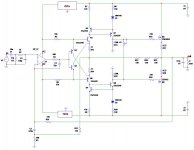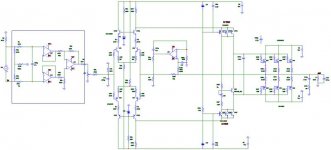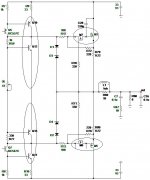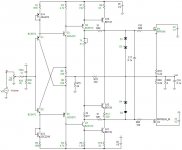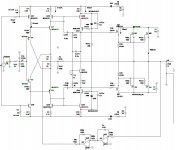vAD said:Hello.
Please. Comment output stage.
Thanks.
Well, the circles at left are: darlingoton VAS and complementary Vbe multiplier. Quite nice.
The output stage looks weird.
M6 and M7 seem to work at 0 bias current. What are they for? Built-in diodes or something?
Also VAS 'sees' only Rload+(R12+R72+R79)/2 to the ground.
I don't understand.
Regards
vAD said:Hello All!! I ask your comments under these circuits,
It is very grateful ÂÀÄ
Nice
A cap parallel to pot would be usefull, maybe even one big electrolytic (like 22uF) parallel with 100nF.
darkfenriz said:
M6 and M7 seem to work at 0 bias current. What are they for? Built-in diodes or something?
Also VAS 'sees' only Rload+(R12+R72+R79)/2 to the ground.
I don't understand.
Hello! Darkfenriz,
R 72, r76. A mistake:
With Gratitude.
I would disagree about putting a cap across the bias pot. I also used to think this would be good but some simulations I have done show that this method causes bias drop problems when the amp clips.
Think of it this way. When the amp clips the 'bias' cap gets dischared. When this happens the bias of the output stage drops and cannot return to proper levels until the cap gets recharged. This means that immediatly after positive or negative clipping you will have some crossover distortion. If you have a fast discharge and a slow recharge then you could have serious sound problems.
Try simulations of a large clipping signal and if the bias voltage drops over time then you could have this problem.
Doug
Think of it this way. When the amp clips the 'bias' cap gets dischared. When this happens the bias of the output stage drops and cannot return to proper levels until the cap gets recharged. This means that immediatly after positive or negative clipping you will have some crossover distortion. If you have a fast discharge and a slow recharge then you could have serious sound problems.
Try simulations of a large clipping signal and if the bias voltage drops over time then you could have this problem.
Doug
I would disagree about putting a cap across the bias pot. I also used to think this would be good but some simulations I have done show that this method causes bias drop problems when the amp clips.
What value cap did you use in your sim and how long is "over time"?
I tried it with a 1uF cap and found a drop of 0.002V after one scecond. The results seemed to have bottomed out at about 0.6s. In any case the curve looked asymptotic. I expect less of an effect with higher cap vlues such as the standard 47uF, and in fact that showed a drop of 0.0005V.
At least for my part, I'm leaveing the cap in my amps. Perhaps the results are topology dependent.
I made a simple simulation and found with a 47u cap a drop of 30 mv plateauing at about 4 ms. There is more drop the longer the time spent clipping and the driver base current, but the time constant depends on the voltage amp collector current and the size of the cap.
I guess the drop is smaller than I had remembered or perhaps it has to do with the topology I was looking at.
I suppose it might help stability some but I dont like the idea that the audio signal can influence the bias.
Doug
I guess the drop is smaller than I had remembered or perhaps it has to do with the topology I was looking at.
I suppose it might help stability some but I dont like the idea that the audio signal can influence the bias.
Doug
Unless the Vbe multiplier is bypassed, audio WILL influence bias, because the Vbe multiplier, taken as a voltage source, has a finite and not very linear impedance (which has to do with nonlinearity of gm vs current). You have to keep in mind that you get variations of Ib of the output stage, hence also variations of current thorugh the Vbe multiplier. At clipping, this problem is the worst. Also at clipping, with the capacitor, you get rectification effects of suddenly increasing Ib, for some topologies. Same thing when the output current limit activates. All in all, it is worth analysing these effects but not overanalysing as neither mode of operation is really 'normal' for amps.
ilimzn, you are right that audio signal does influence bias because of current source impedence and changes in bias current. However, I think these kind of effects are straightforward to recognize because they show up on even simple simulations. They also disappear immediatly whenever the signal returns to normal levels.
In the case of clipping and having a bias capacitor the bias remains reduced (admittedlty only slightly) for a short time after the signal has disappeared. Therefore it can affect other signals than occur after the clipping. And not many people actually look at changes in bais due to clipping so the effect might be overlooked in simulation.
Of courcse, if you look at the problem psycho-acoutically (?) then it would be worst when large clipping is followed by a quiet passage. If the bias recovery time is short enough then you probably cannot hear it. Oh well.
Doug
In the case of clipping and having a bias capacitor the bias remains reduced (admittedlty only slightly) for a short time after the signal has disappeared. Therefore it can affect other signals than occur after the clipping. And not many people actually look at changes in bais due to clipping so the effect might be overlooked in simulation.
Of courcse, if you look at the problem psycho-acoutically (?) then it would be worst when large clipping is followed by a quiet passage. If the bias recovery time is short enough then you probably cannot hear it. Oh well.
Doug
- Status
- This old topic is closed. If you want to reopen this topic, contact a moderator using the "Report Post" button.
- Home
- Amplifiers
- Solid State
- Please comments
